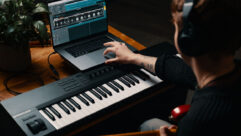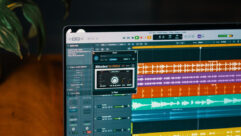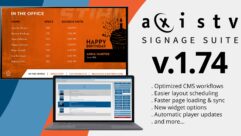
A/V at A.V.H.S.
Mar 1, 2002 12:00 PM,
By Keith Clark
The Apple Valley High School Eagles are a bright and enthusiasticlot as a rule. They enjoy a diverse academic experience that includesmany cocurricular activities. Case in point: Rehearsals for this year’smusical production, The Sound of Music, are hot underway. Theproduction brings together the theater, choral and instrumental musicdepartments for a gala production. Sets are built and lights are run bystudents assisted by school faculty. And this year, a new performancetheater featuring a dramatically improved sound reinforcement system islikely to lead to more awards for the student stars.
The theater, busy virtuallyevery day of the school year with performances and rehearsals, hoststhree big dramatic/musical productions each year, plus choral concertsand festivals, numerous band concerts and more. The excellence of theprogramming at this 2100-student Minnesota high school is confirmed byits third consecutive selection as a Grammy Signature School, anational honor.

Kingdom Sound & Lighting, in nearby Burnsville, is one of theleading contracting firms in the greater Minneapolis-St. Paul area. TheKSL team recently completed work on phase one of an upgrade to theschool’s sound reinforcement system, including new house loudspeakers,digital signal processing and amplification. Additional phases, such asthe installation of a new house console, are expected to be addressedover the next two years.
Gary Johnson, who frequently collaborates with the contracting firmon higher-end projects, provided the system design, working closelywith Loren Bartelt, head of Kingdom Sound. In addition, Chris Moen, afreelance sound engineer who assists in supervising the systems at thetheater, offered invaluable information and support to the soundteam.
WHERE THE MAGIC HAPPENS
The theater is about threetimes wider than it is deep (approximately 120 by 40 feet), with acapacity of 860 seats fanning outward from the stage, gently rising tothe curved back wall. Acoustics are good according to the sound team,with acoustical clouds forming dual concentric rings above the stage,extending out over a portion of the audience area. All seats arepadded, and the aisles are carpeted.

“The choral people [are] concerned that the room may be just abit too dry from an acoustical standpoint, so future plans call forlivening it up electronically,” sound designer Johnson notes.“We’ve done some preliminary work in this regard, focusing on thefuture placement of six loudspeakers — three per side —along a ceiling ridge toward the rear of the room. In fact, cabling hasalready been put into place in the front-of-house loudspeaker patchpanel that will allow access and signal routing to these loudspeakersonce they’re installed.
“This subsystem will be available for providing specificeffects to enhance theatrical productions and for adding a generalfullness of sound to the room. Processing, including delay, will alsobe a part of this effort,” he adds.
Given the extreme width of the room, a left-center-right loudspeakerarrangement was used to of- fer the best possible coverage, in additionto increased spatial imaging. Using modeling tools, includingAcoustaQWIK and EASE, the focus became a center arraydedicated to providing point-source vocal coverage throughout theentire room, with left and right arrays providing stereo music.
“This space is great for the sense of intimacy it provides inrelation to the stage,” Johnson says. “Most theaters aredeeper than they are wide, and you lose that intimacy. The challenge,however, comes in devising a system that fits and works optimallywithin a much wider coverage area.”
The previous system, in place for more than a decade, had becomeoutdated and needed replacement. This project afforded a greatopportunity to address problems of uneven coverage and comb filtering.As they do on many higher-end projects, Kingdom Sound & Lightingselected Renkus Heinz loudspeakers, preferring their natural, uncoloredsonic signature, particularly the smooth-yet-present high-frequencycharacteristic and tight, accurate, predictable pattern control.
FLYING THE EAGLES’ SPEAKERS
Single rh ce153/12 three-way full-range loudspeakers (with passivemid/high) were deemed an optimum solution based on the modeling. Thesespeakers are flown left and right above the front portion of the stageat about 18 feet from the floor and 60 feet apart. Modeling also helpeddetermine the optimum, gently downward-facing angle for these twoloudspeakers anchored into place by ATM Fly-Ware eyebolt/aircraftcabling hardware.
The CE153/12 was designed specifically for wide but shallow rooms,like theaters. It provides wide-angle 120° horizontal coverage, aswell as asymmetrical 50° vertical coverage (+20°/-30°)that helps direct more sound to the audience and off the reflectiveceiling surfaces. CE153/12s also include Renkus Heinz’s proprietaryCoEntrant Waveguide Technology, which offers a truer point-sourceperformance, as well as natural alignment and controlleddispersion.
Feeds to all main loudspeakers are assigned from the subgroups ofthe existing Soundcraft Delta Series house console (slated forreplacement in the next phase of the project). Stereo music programmingrouted to the pair of CE153/12s includes portions of both left andright mix.
“We set it up so that you get parts of both mixes in eachspeaker,” Johnson explains. “For the most part, of course,programming is dominant with respect to traditional routing —left speaker gets more left channel info, and same with right —but mixing it together supplies better overall imaging. A bit of thiseffect is lost as you move more toward the far corners of the coveragearea, but this is inevitable. You can’t completely fight proximityissues.”
The center array is made up of four Renkus Heinz TRAP40MH/7 mid/highmodules, positioned about 5 feet forward of the line between theleft/right loudspeakers in deference to a video screen that occupiesthis location. These loudspeakers are arranged in a single-levelhorizontal array, with each loudspeaker aimed to cover its respectiveseating section. Transitioning between cabinets occurs in theaisles.
“It’s great to keep the vocals tight in the center channel andthen spread the music mix between left and right,” says Moen.“There’s great stereo imaging, particularly with thesespeakers.” TRAP 40MH/7 mid/high modules also have a CoEntrantdesign that bolsters point-source characteristics, with a 40°horizontal coverage pattern and asymmetrical 75°(+30°/-45°) tightening focus of energy on the coverage area.True Array Principle (TRAP), another proprietary Renkus Heinztechnology, helps place the acoustic centers of each loudspeaker innear-perfect alignment when used in arrays.
Unlike the left/right loudspeakers, the center array loudspeakershave no downward tilt. Modeling helped ascertain this optimumpositioning. Acoustical foam was attached to the underside of theconcentric panel above this array, further helping to eliminate earlyreflections. Also flown with 12-point Renkus Heinz TC4-RHANG hardware,the center array is painted to blend in beautifully with the wood ofthe concentric circles as well as that of the room walls.
“The RH TRAP arrangement is virtually seamless and quiteremarkable, particularly in the vocal range,” Bartelt says.“The look of these particular loudspeakers for this project isgreat as well, and that’s one of the things the client rates highly.We’ve had a lot of positive comments about it.”
The mid/high loudspeakers are accompanied by dual Electro-Voice TL12low-frequency loudspeakers, selected based on the sound team’sexperience with them and on budgetary constraints. These arehorizontally stacked and flown above the TRAP array and concentriccircle surface.
THEATER SUBTLETIES
The unique shape and configuration of the room presented a challengewith respect to subwoofer location. After considering a number ofoptions and evaluating them with modeling, the sound team chose twocompact Acoustic SBT 2.6 subs mounted at the ceiling level, one perside. Positioned sideways and held firmly in place with custom steelframes designed by Kingdom Sound & Lighting, these project intoangled concrete soffits that both diffuse and distribute energy evenlythroughout the room.
“There were a number of challenges on the installation side ofthis project, particularly with respect to flying all of theseloudspeakers in their optimal positions within an existingstructure,” Bartelt notes. “First, given the heavy use ofthe room, it was tough finding enough concentrated time to get in anddo the job. We were able to arrange a 3-day period to do the wholething. Suffice to say there were no 8-hour days.
“New cabling was rundown the ceiling catwalks, and getting around the acoustical clouds wascomplicated. You can’t walk on these structures, so lifts and scaffoldswere positioned between and around them, as close as possible,”he continues. “The subs were especially tough, getting them wayup there, secured in the framework, and then properly cabled andconnected.”

A FLEDGLING FLIGHT
this project also marked one of the first applications ofQSC‘s new 2-channel DSP-3 programmable digital signal processormodules, which attach to the rear 2-channel data ports of the four newQSC CX-Series amplifiers driving the new house loudspeakers. (Twoexisting JBL amps were retained to drive stage monitors, and all ampsare rackmounted in the sound booth.)
Using his laptop outfitted with the DSP-3 software package linked tothe modules via RS-232 ports, Johnson established all systemprocessing, including parametric equalization, crossover filtering,compression and limiting. Johnson notes that one feature that workedreally well was the ability to add delay to enhance the voices ofactors and performers. All of the optimized settings arepassword-protected to prevent tampering; and for added protection, theexisting software used to do the programming must be used to make anychanges. No other version will provide this access.
“This DSP product is pretty incredible and a really goodvalue,” Johnson says. “It has two channels of DSP thatallow you to build blocks of whatever you need in terms of EQ,crossover, etc. This is the product that we, as sound contractors, longdreamed of. You don’t have to wire a bunch of signal processors, butyou can go right from the house console into the processor and theninto the amp. These units are also clean-sounding and quiet.”
A Rane ME-60 dual 30-band graphic equalizer is inserted toallow tailoring of the stereo music mix, and, as previously mentioned,the existing Soundcraft console is still in place, with its subgroupsproviding both LCR and sub feeds. It’s not ideal, but it works for nowand will suffice until a suitable replacement can be made, preferablyone with true LCR panning capability.
NEXT STEPS
while the new console issue is yet to be finalized, Bartelt notesthat another goal is to move the mix position into the house, gettingit out of the enclosed booth. Not only is it tough to accurately hearthe system while mixing, but also the cramped confines of the boothnecessitate positioning the console sideways rather than facing thestage.
“Ideally, we’d like to build the new position where theconsole could be rolled out from the center of the back wall into theaudience,” he explains. “[It] would dramatically improvethe situation. Especially with LCR, it would be a great central vantagepoint to get a feel for what the system is doing.”
Right out of the gate, the new system proved up to matching theschool’s expectations when used with an original production based on2001: A Space Odyssey. The show featured a full band, singersand choruses, and recorded tracks joining video and lightingelements.
“The imaging opened things up beautifully, accompanied by alow end that literally shook the seats,” Johnson says. “Theproduction values were impressive at any level, and especially for ahigh school. And with Chris [Moen] leading the audio effort, it’sreally coming together.”
“The room already presented an incredible opportunity in termsof a live sound environment,” Moen concludes. “This system,matched so well with its environment, has an impact that’s almostmind-boggling.”
Keith Clark is an independent writer for the pro sound industryand has authored hundreds of system application articles.
Learning to Fly
Straightforward SystemDesign Allows For a Learning Opportunity
Chris Moen, the freelance engineer who supervises the theater’ssystems says, “We allow and encourage students to work the soundsystem, with appropriate supervision, of course. This is a learningopportunity that’s rare. They won’t learn if I do it all, and that’snot the point. Students should have the chance to learn about systems,learn about mixing. I just show them the basics and let them proceedfrom there.”
For More Information
Acoustic
acoustic.mu
ATM Fly-Ware
atmflyware.com
Electro-Voice
electrovoice.com
JBL
jblpro.com
QSC
qscaudio.com
Rane
rane.com
Renkus Heinz
renkus-heinz.com
Soundcraft
soundcraft.com










